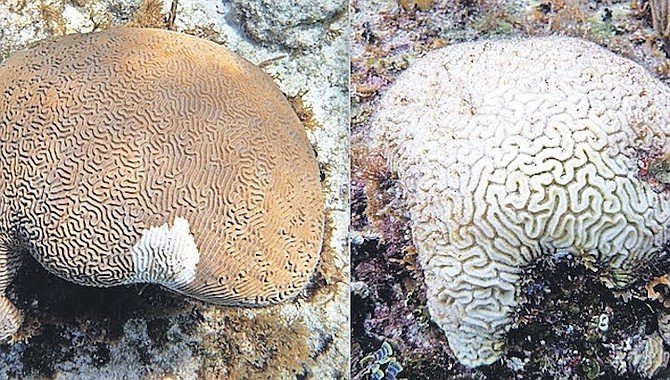BEFORE and after: When a coral becomes infected with Stony Coral Tissue Loss Disease (left) it can be completely dead within a matter of weeks (right).
By RASHAD ROLLE
Tribune Senior Reporter
rrolle@tribunemedia.net
BAHAMIANS must “sound the alarm” and the government must take swift action to address stony coral tissue loss disease, a fast-spreading bacteria that is ravaging coral reefs throughout the country, says Waterkeepers Bahamas President Joseph Darville.
In a letter yesterday, Mr Darville said he visited Grand Bahama recently and saw the destruction for himself. He said the threat to coral reefs cannot be exaggerated.
“What I saw can only be described as an underwater massacre,” he said. “I have never seen anything like it - huge swaths of formerly vibrant reefs, once bursting with colour and life, have become barren, lifeless desert. A cold, grey, underwater graveyard.”
Rochelle Newbold, director of environmental planning and protection, told reporters in December that 90 percent of coral reefs off Grand Bahama have already been devastated by SCTLD. She said the problem is significant enough that young Bahamians should begin rethinking career paths that involve marine systems.
The destruction of reefs will also leave the country more vulnerable to climate change.
Florida’s Department of Environmental Protection says about $16m worth of projects have been funded since 2015 to stop the disease in waters around Florida. It is not clear how much has been spent locally.
Mr Darville said: “Florida is pumping millions of dollars into saving its reefs. Other countries in the region are taking action. Meanwhile, our politicians and civil servants continue to shuffle papers around without any end in sight.”
Mr Darville said the Perry Institute for Marine Science (PIMS) approached the Minnis administration in 2020 and explained the serious and time-sensitive nature of the crisis. He said PIMS recommended forming a multi-agency task force to develop and implement a plan specific to The Bahamas.
“For more than two years, the scientists and divers have been waiting for the green light to begin taking action, but unfortunately, their initiative has become mired in bureaucracy and red tape. Meanwhile, the disease spreads further with each passing day. It has now gained a foothold in San Salvador, Eleuthera, Long Island, the Berry Islands and maybe others,” he said.
“As the local environmental community never tires of saying, bureaucracy has no place in the fight to save our oceans, our resources and the tens of thousands of jobs that depend upon the blue economy in The Bahamas…Lacking the necessary permits and approvals, the hands of the PIMS scientists are tied and have remained so for more than two years.”
SCTLD, a bacteria, was first found in corals off Miami in 2014. Currently, there is no cure for the disease, although its spread can be slowed or stopped when Amoxicillin, an antibiotic, is applied strategically to affected reef systems along with other measures.
Mr Darville said: “The predictions for The Bahamas are dire: if nothing is done, up to 90 percent of certain brain corals once common on near shore reefs will die, rendering those species locally extinct. The disease is also targeting so-called ‘coral dinosaurs’, formations that took hundreds of years to form, but which are disappearing in the blink of an eye.
“Before long, it is expected that local fish numbers will begin to plummet, along with sharks, sea turtles and other marine wildlife dependent on coral reefs. The fallout is also likely to accelerate erosion of our coasts, as fewer reefs mean bigger waves pummelling the shore. A low-lying country like The Bahamas will also be affected by even more flooding than we already experience, especially in the face of the stronger and more frequent hurricanes and tropical storms that come with climate change.
“Eventually, seagrass beds, mangroves and other near shore habitats that are biologically interconnected with the reef systems will begin to die, while our world-renowned beaches will begin to wash away and disappear. The cataclysmic effect this will have on our tourism industry, our fisheries, our dive operations and our general way of life as island people, is incalculable. I do not exaggerate in calling this a national crisis of the highest order for The Bahamas.”
He added: “Boaters, divers, fishermen and ocean-lovers can contribute to stopping the spread of SCTLD. The first way is by learning how to identify the disease and to report sightings so that PIMS can continue to monitor the spread.
“Next, when snorkelling, spearfishing or scuba diving, it’s important to disinfect your gear after each dive to avoid accidentally spreading the disease between reefs. Dunking your gear in a bucket of seawater with sodium percarbonate (commonly found in eco-friendly laundry detergent) added works well. Also, boaters should be careful not to transport water between reefs. Be sure to pump out any bilge at reefs where SCTLD is present. Disinfect any remaining bilgewater with a natural detergent and release it into open water away from reefs.”





Comments
Proguing 2 years, 2 months ago
How about making the cruise ships pay for the rehabilitation of our reefs?
One 2 years, 2 months ago
"significant enough that young Bahamians should begin rethinking career paths that involve marine systems"
Open for interpretation
Should they rethink because the country will offer jobs with competitive pay and adequate funding to protect the marine systems?
Or because there's no hope that anything meaningful will be done and our marine systems will be lost so don't bother with this career.?
I see no evidence that our leaders will do anything but perpetuate the slack corrupt greed lifestyle.
Sign in to comment
Or login with:
OpenID